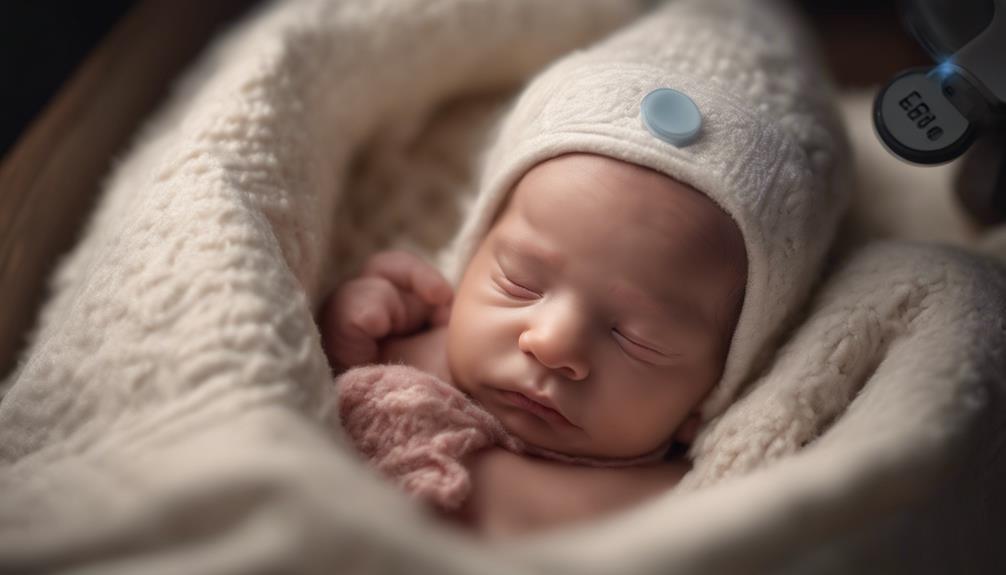In our medical environment, maintaining the appropriate body temperature of newborns is a critical component of delivering high-quality care.
When thinking about the delicate balance of a newborn's body temperature, one can't help but consider the intricate details that go into creating an effective care plan.
From understanding the nuances of heat loss to implementing precise temperature regulation guidelines, the components of this plan are essential for the well-being of our youngest patients.
Would you like to explore how these strategies can impact outcomes for newborns in our care?
Key Takeaways
- Proper thermoregulation is vital to prevent hypothermia in newborns.
- Utilize warmers, blankets, and kangaroo care for temperature maintenance.
- Monitor skin temperature closely and adjust environmental factors accordingly.
- Implement interventions promptly to manage hypothermia and prevent complications.
Importance of Thermoregulation
Highlighting the critical significance of maintaining proper thermoregulation in newborns is essential for safeguarding against hypothermia and ensuring their physiological stability. Infants, especially premature, underweight, and sick ones, are at a higher risk of hypothermia due to limited fat stores and immature temperature regulation mechanisms. Their delicate bodies struggle to generate and retain heat efficiently, making them susceptible to fluctuations in temperature.
As nursing professionals, we realize the importance of monitoring their skin temperature closely and considering environmental factors that could impact their heat balance. By providing a warm, cozy environment, we help prevent unnecessary heat loss and support their bodies in conserving oxygen for vital functions. Every degree matters in their care, and our interventions play a critical role in maintaining a stable body temperature.
Through meticulous nursing care and attention to detail, we can create a nurturing space where these vulnerable newborns thrive and develop at an optimum level.
Strategies for Temperature Maintenance

To guarantee top care for newborns' thermoregulation, we implement a range of strategic measures focused on maintaining a stable body temperature. Ensuring a neutral thermal environment is essential to prevent hypothermia and support the physiological stability of newborns. Our strategies include utilizing equipment such as warmers, incubators, and thermal blankets to regulate body temperature effectively. Monitoring skin temperature probes and adjusting cot temperatures play an important role in optimizing thermoregulation for infants. Additionally, promoting skin-to-skin contact through kangaroo care aids in maintaining body temperature and fostering bonding between parents and the newborn. Educating parents on dressing their newborn appropriately and recognizing signs of heat loss is necessary for effective temperature management. By employing these methods, we aim to create an environment that minimizes heat loss and maximizes the baby's comfort and well-being.
| Strategies for Temperature Maintenance | Benefits |
|---|---|
| Utilizing warmers, incubators, and thermal blankets | Regulates body temperature effectively |
| Monitoring skin temperature probes and adjusting cot temperatures | Optimizes thermoregulation for newborns |
| Promoting skin-to-skin contact through kangaroo care | Maintains body temperature and fosters bonding |
Assessing Newborn's Body Temperature
When evaluating a newborn's body temperature, it's essential to use a digital thermometer to monitor for any deviations from the normal range of 36.5–37 °C. Newborn infants rely on metabolic processes, such as metabolizing brown fat, to generate heat, while factors like muscle tone and environmental temperature influence heat loss.
Maintaining the axillary temperature within the normal range is critical for the baby's physiological stability and comfort. It's important to take into account the newborn's weight, gestational age, and postnatal age when regulating the environmental temperature to guarantee ideal thermoregulation.
Strategies like dressing the baby appropriately, using radiant warmers, and employing thermal blankets play a significant role in preserving the infant's body temperature. By paying close attention to these details, we can create a nurturing environment that supports the newborn's thermal needs and overall well-being.
Managing Hypothermia and Hyperthermia

Turning our attention to managing hypothermia and hyperthermia in newborns, it's essential to recognize the critical temperature thresholds and associated risks for these conditions.
Hypothermia, defined as a body temperature below 36 °C, poses a significant threat to preterm and underweight infants. Complications can escalate when an infant's temperature drops below 35 °C, particularly if the rectal temperature falls below this critical point. Signs of hypothermia may manifest as cold skin, lethargy, and poor feeding, necessitating prompt warming, energy provision, and vigilant life sign monitoring for effective treatment.
On the other hand, hyperthermia, characterized by a body temperature above 37 °C, often stems from environmental heat or infections, putting infants at risk of issues like recurrent apnea and dehydration. Metabolic problems in hypothermic infants can encompass hypoglycemia, hypoxia, metabolic acidosis, anaerobic metabolism, and disseminated intravascular coagulopathy, demanding interventions such as warming, energy supply, oxygen, and sodium bicarbonate to address these critical concerns in newborns' thermoregulation.
Documentation and Care Plan Implementation
Let's guarantee meticulous documentation and meticulous implementation of the care plan for newborn thermoregulation. Documenting the neonate's temperature readings and the equipment used is essential to monitor thermoregulation effectively.
Implementing nursing care plans involves adjusting the environmental temperature according to the neonate's gestational age and weight. It's critical to regularly assess skin temperature probes and assure their proper placement to prevent heat loss and support thermoregulation adequately.
Monitoring and documenting hourly temperature assessments are crucial for maintaining a neutral thermal environment and preventing fluctuations in core body temperature. Implementing transfer protocols to open cots and considering environmental factors play a significant role in the overall care plan.
Ensuring the neonate's skin temperature is stable, whether in an incubator or radiant warmer, helps regulate their metabolic rate and promote best growth and development. By adhering to these guidelines, we can provide the best care and support for newborns in need of thermoregulation assistance.
Frequently Asked Questions
What Nursing Interventions Are Essential to Ensure Adequate Thermoregulation in the Newborn?
We prioritize newborn thermoregulation through skin-to-skin contact, monitoring environmental temperature, and providing appropriate clothing. Educating caregivers on hypothermia signs and home care is essential. Utilizing warmers and incubators when needed guarantees the best thermal stability for our precious newborns.
What Are the Guidelines for Thermoregulation of Newborns?
When caring for newborns, guidelines for thermoregulation are important. Factors like gestational age and weight influence the need for assistance. Monitoring skin temperature is essential. Equipment such as isolettes and radiant warmers support this care.
What Are 5 Nursing Actions to Promote Warmth or Prevent Hypothermia in Newborns?
We maintain newborn warmth by monitoring skin temperature, providing proper clothing, using radiant warmers, and ensuring kangaroo care. These actions promote bonding and prevent hypothermia. Swaddling, incubators, and regular checks support a cozy and stable environment.
What Is the Best Way to Regulate Newborn Body Temperature?
Ensuring a newborn's body temperature is vital. We monitor closely and use external heat sources when needed. Moving from an incubator to Kangaroo Care is a milestone. Tailoring care based on risks is essential.
Conclusion
To summarize, ensuring proper thermoregulation for newborns is like a well-oiled machine – each component working together seamlessly to maintain the perfect balance.
By following the guidelines outlined in the care plan, healthcare providers can help these vulnerable little ones thrive and grow.
Let's continue to be vigilant, compassionate, and detail-oriented in our care to give every newborn the best possible start in life.








